|
|
Cornish and Lloyds Agricultural Engineers
and
the story of George Cornish Engineering, workshops and Foundry
| 1830 |
In Pigot's Directory of 1830 there were only three Iron and Brass Founders recorded in Bury St Edmunds. These were:
- George Childs, (Brass), 3 College Street
- Charles Colman, 62 Guildhall Street
- Samuel Ridley, 25 Abbeygate Street
|
| 1836 |
Research by Graham Ferguson published in his book, "The Plowright Story", reveals that in Swaffham in West Norfolk there was only one foundry in that town in 1836, and that was known as "Hunton and Cornish". The foundry proprietors were Jonathan Hunton and John Cornish. The directory containing this information was White's Directory of 1836.
|
| 1839 |
Pigot's Directory for 1839 omits the category of Iron and Brass Founders, and none appear to be listed elsewhere.
|
| 1840 |
At Swaffham in late 1840, a new foundry was being established in competition with Hunton and Cornish by the brothers W and H Plowright. Whether this had anything to do with it or not, on 11th October, 1840, the partnership of Hunton and Cornish was dissolved, according to a notice in the Norfolk Chronicle for 28th November, 1840.
John Cornish now moved his family to Bury St Edmunds, while Jonathan Hunton continued running the foundry at Swaffham.
This move is confirmed by the fact that according to the George Cornish advertisements after 1887, the firm was established here in 1840. When George Cornish became Mayor in 1891, he said that he was in his 50th year of living in Bury St Edmunds. It therefore seems probable that the Cornish family of iron and brass founders did indeed come to Bury St Edmunds in 1840 to set up a new business here.
|
| 1841 |
In the census of 1841 there was a a John Cornish as 51 years old, living at Westgate Street, Bury St Edmunds. He was born about 1790 in Wilby Suffolk. The full listing was as follows:
- John Cornish, aged 51, Iron Founder;
- John Cornish 29yrs (ditto);
- George Cornish 16yrs; Machine Maker
- Frances Cornish female 50yrs;
- Mary Ann Cornish 27yrs; Not born in Suffolk
- Caroline Cornish 18yrs; Bonnet maker
- Harriett Cornish 15yrs;
- Elizabeth Cornish 9yrs;
- Mary Ann Cornish 7yrs; Not born in Suffolk
-
also Mary Anne Cornish 5yrs;Not born in Suffolk
- John Cornish 1yr infant ; Not born in Suffolk
|
| 1844 |
In White's Directory of suffolk for 1844,
John Cornish and Son were at two locations.
Bury had 12 blacksmiths listed, but only two firms were listed as Iron and Brass founders. These were
- John Cornish and Son at 62 Westgate Street,
- Pritty and Hodgson at 63 Abbeygate Street.
John Cornish and Son were also listed as Machine Makers at 62 Whiting Street. There were three firms listed as Machine Makers, as follows:
- John Cornish and Son at 62 Whiting Street,
- Henry Backham at 32 St Johns Street,
- Henry Smith at 22 Westgate Road.
|
| 1851 |
In the 1851 census George Cornish was living with his father, John Cornish, head of the household, at 63 Westgate Street in Bury St Edmunds. The full entry was as follows:
- John Cornish was 62, described as an "Ironfounder employing 10 men", born at Wilby in Suffolk, in 1789.
- His wife, Finis was also 62, born at Wymondham in Norfolk.
- John Cornish, (junior) married, aged 39, born in 1812 at Wilby, "Iron and Brass Founder"
- George Cornish, single, aged 27, born 1824 at Wilby, "Iron and Brass Founder"
- Harriett Cornish, single, aged 25, born in 1826 at Wilby, no occupation recorded
- Elizabeth Cornish, single, aged 21, born in 1830 in Norfolk, "Milliner"
Others in the household were:
- Mary Ann Cornish, daughter in law, presumably wife of John junior, aged 37 born in 1814, from Norfolk
- Mary Ann Cornish, grand daughter, aged 15, born 1836 in Norfolk, scholar
- John Cornish, grand son, aged 11 born in 1840 in Norfolk, scholar
- George Cornish, grand son, aged 5, born in 1846 at Bury St Edmunds, scholar
- Pleasance Cornish, aged only a few months, born in 1851 at Bury St Edmunds
- Walter Butters, grand son, aged 16, born in 1835 at Swaffham in Norfolk. "Iron Founders Apprentice"
- Thomas Chinery, nephew, aged 26, born in 1825 at Wilby in Suffolk, "Moulder"
| 1855 |
In the London Gazette 1855 page 2665 is found the following official public record concerning applications for patents:
Patent Law Amendment Act, 1852.
Office of the Commissioners of Patents for
Inventions.
"NOTICE is hereby given, that—
......................
478. And Robert Boby, of St. Edmund's, Machinist,
and Thomas Cooper Bridgman, both of
the same borough, in the county of Suffolk,
Chemist, have given the like notice in respect
of the invention of " improvements in corn
dressing and winnowing machines."
As set forth in their petition, recorded in the said
office on the 3rd day of March, 1855."
In Bury, Robert Boby, who was an ironmonger on the ButterMarket, had now decided to set up a factory to build this newly patented agricultural machinery. Boby had been recorded as an Ironmonger, Brazier and Turner as early as 1843. In 1855 he built the Improved Corn Dressing and Winnowing machine to separate corn from chaff, and won a gold medal with it at the Chelmsford Show in 1856. He decided to go into manufacturing rather than license the invention to anyone else. Presumably Bridgman would receive a royalty on each machine sold.
Such new and relatively heavy machinery could now be shipped easily to anywhere, home or abroad, via the railway system which covered all major ports by this time. This was to be very important for the development of industry in the town. At this time there were probably still about 300 families in Bury involved in agriculture, while the largest single source of employment was probably in domestic service. The Gas Works was the only other industrial type of work available.
It seems likely that George Cornish now decided to move from his father's firm, to work for Robert Boby in setting up his new factory. He would stay there for 10 or 11 years, and when he left Boby in 1865, he was Boby's Manager.
|
| 1856 |
In the first full year of production, Robert Boby produced 200 Corn Screens of his and Bridgman's own design. These would become very popular and by 1887 he would sell over 13,000 units all over the world.
At the Chelmsford Royal Show of 1856, the Corn Dressing and Winnowing Machine built in Bury St Edmunds won a Gold Medal.
|
|
|

George Cornish marries Maria Syrett |
| 1859 |
On March 10th, 1859 George Cornish, the Iron founder, married Maria Jeffes Syrett at St Mary's church, in Bury St Edmunds. She was the only daughter of William Syrett, also of Bury St Edmunds. (BNP 12th March, 1859) William Syrett was a civil and mechanical engineer specialising in water supplies and drainage matters. He also offered to design steam engines and to improve the performance of existing engines. In 1867 R Syrett and Son were listed as Ironfounders/Ironmongers at 61 Whiting Street, Bury St Edmunds, while William Syrett was listed under the heading "Engineers", and located "near railway station".
Thomas Cooper Bridgman, who had probably been the main inventor of Boby's Patent Corn Screen died in 1859, at the age of only 53 in Bury St Edmunds.
|
| 1860 |
On 11th January 1860 Ransomes and Sim's Agricultural Implement Warehouse was opened at 10 Meat Market, Bury St Edmunds, with William Clark as resident agent. A large advertisement to this effect was placed in the Bury and Norwich Post for 3rd January, 1860.
|
| 1861 |
In the 1861 census, the large Cornish family had divided into two households, although they lived next door to each other at 8 and 9, Whiting Street.
John Cornish junior was head of household at number 8, aged 49
- John Cornish, Head, aged 49, born at Swaffham, married, "Iron Founder"
- Marianne Cornish, his wife, aged 47, born at Swaffham
- John Cornish, his son, aged 21, born at Swaffham, single, "Iron Founders Clark"
- George Cornish, his son, aged 15, born at Bury St Edmunds, "Engine Fitter"
- Pleasance Cornish, daughter, aged 10, born at Bury St Edmunds, "Scholar"
- Harry Cornish, son aged 7, born at Bury, "Scholar"
- Kate Cornish, daughter, aged 6, born at Bury, "Scholar"
George Cornish was head of household at number 9, Whiting Street.
- George Cornish, married, aged 37, born in 1824 at Wilby in Suffolk, "Iron Founder and Engineer"
- Maria Cornish, his wife, aged 30, born in 1831 at Bury St Edmunds
- Fryphena Cornish, his mother, now a widow, aged 72, born in 1789 in Norfolk.
- Susan Batcock, his sister, a widow, aged 47, born in 1814 at Wilby, Suffolk
- Mary Ann Smith, his sister, unmarried, 28, born in 1833 at Swaffham in Norfolk, aged 28, "Jewelers Shop Assistant"
- George Smith, Uncle, married, aged 60, born in 1801, at Wilby in Suffolk, "Retired Hackney Master"
|
| 1862 |
In 1862 Boby was exhibiting at the London Exhibition in Class IX, "Machines for cleaning and separating grain, and improved wort pump for brewers." It was claimed that, "Has obtained and still holds the First Prize and Silver Medal of the Royal Agricultural Society or England, and 30 other First-class Prizes.
4,000 of these machines have been sold in 5 years."
|
| 1863 |
In January 1863, George Cornish appeared as a character witness on behalf of a Thomas Redditt, caught poaching at Risby. Cornish said that he was "connected" with Mr Boby's establishment and had thus known the defendant, a blacksmith, for 11 or 15 years. This statement seems to imply that Cornish had been working for Robert Boby since he began his agricultural machinery manufacture in 1855.
In 1863 Josiah Le Butt, who worked for Robert Boby had a patent taken out for: "Machinery for dressing grain. being Patent Number: 504 published: 24 February 1863". Le Butt would eventually decide to start up on his own to make some of his 'improved' machinery.
|
|
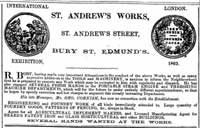
Robert Boby announces George Cornish leaving him. |
| 1865 |
On 3rd January 1865, Robert Boby placed an advertisement in the Bury and Norwich Post to announce that he was reorganising the management of various parts of his factory. The immediate cause of this seems to be that George Cornish, who had hitherto been his factory manager, had now left his employment in order to take over his father's foundry business of Cornish and Sons, to trade as George Cornish.
|
|
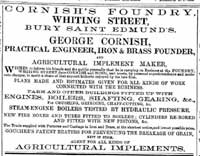
George Cornish takes over Whiting Street foundry |
|
blank |
In April 1865, George Cornish announced that the Iron and Brass Foundry Business previously trading as Cornish and Sons, in Whiting Street, would from now on be known as George Cornish, Practical Engineer, Iron and Brass Founder, and Agricultural Implement maker.
|
|
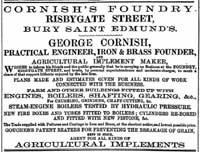
George Cornish relocates foundry to Risbygate Street |
|
blank |
By September of that year, George Cornish was advertising his foundry was now relocated to Risbygate Street in Bury St Edmunds. This foundry would last on that site until the 1960s. The Whiting Street foundry was apparently given up at this time.
|
| 1866 |
In October, 1866, Edward Greene, the brewer, gave a celebratory dinner in the Theatre Royal for 350 of his workmen and those of Robert Boby and George Cornish, the Bury Engineers. It celebrated another expansion of his Westgate Brewery. He had added a second steam engine to the brewery, a ten horsepower machine built by George Cornish. Cornish did Greene's engineering work from 1850 to 1880, while Boby's supplied malt screens and made other malting equipment and agricultural devices. All the work had been undertaken by firms in Bury, a source of pride for Greene, who had been elected as one of the town's two MP's a year earlier.
George Cornish's Foundry was in Risbygate Street, where the B & Q store is now located. Boby's Works was in St Andrews Street South, now also replaced by shops like Waitrose, and other development.
This celebratory event marked a great revival in Bury as a manufacturing town, and a new prosperity for the workers of the town. Both pub and home brewing were being rapidly replaced by brewing and malting on an industrial scale, and with the new foundries, these all gave alternative job opportunities to the poorly paid agricultural worker looking for a new start.
|
|
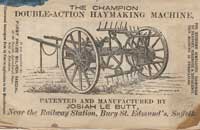
Le Butt's advert in Wilkin's 1867 |
|
1867
|
During 1867 the Bury firm of Wilkin and Son, of 2 Angel Lane and 16 Guildhall Street, published their "Guide to the town and Antiquities of Bury St Edmunds", with a classified list of Trades and Professions. Robert Boby appeared as usual, but his brother, George Boby, now appeared under the heading of Corn and Seed Merchants, with the annotation, "See Cooper, Tozer and Co." Cooper Tozer were located at 18 St Johns Street, and George Boby was now that firm's principal.
The London Gazette of June 21st, 1867 announced that Josiah Le Butt of the Haymaker Works in Bury St Edmunds was awarded a patent for, "improvements to hay making machines." This patent was the basis upon which Le Butt would build a new business.
Robert Boby placed an advertisement in Wilkin's Directory, as did his new competitor, Josiah Le Butt, who advertised a haymaker to rival Boby's own. Boby, however, could afford to take two pages to Le Butt's single page. Josiah Le Butt had been working with Robert Boby, firstly as a representative, and then in the factory, for some 13 years, but had now set up on his own, near the Railway Station. At first he concentrated upon his Champion Haymaker, which, he said, was a great improvement upon the Boby version, to which Le Butt had added his own patented improvements.
|
|
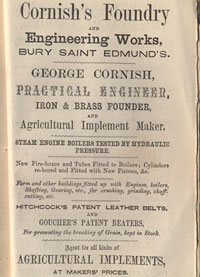
George Cornish advert in Wilkins Guide |
|
blank |
George Cornish also took out a page advertisement in Wilkin's Guide. He claimed to be a Practical Engineer, Iron and Brass founder and an agricultural implement maker. He was also involved with steam boiler testing, which was a necessity for anyone wishing to build a steam engine of any sort at the time. Leather goods for use in agriculture were produced and he was an agent for other agricultural implement makers.
|
|

Boys at work |
| 1869 |
George Cornish, like most other employers at the time, employed small boys to carry out minor tasks. Although the work was unskilled, it could often be dirty and dangerous. This newspaper report from the Bury and Norwich Post of 9th October, 1869 shows that Cornish would carry out boiler maintenance for other firms, using boys to reach the inaccessible inner workings of boilers. The report illustrates the dangers of life in such an environment.
|
| 1871 |
In the 1871 census, George Cornish was living at 44 Risbygate Street.
- George Cornish, head of household, aged 47, born at Wilby in Suffolk, "Ironfounder, Enginemaker and Machinist, employing 22 men and 6 boys".
- Maria J, his wife, aged 40, born in Bury St Edmunds,
- Fryphena Cornish, his mother, a widow, aged 83, born at Wymondham, Norfolk,
- Susan Batcock, his sister, widowed, aged 67, born at Wilby,
- Mary A Cornish, his sister, single, aged 38, born at Swaffham, "Jewellers Assistant"
- Mary I Syrett, niece, single, aged 15, born in London, Scholar
- Ebenezer Harrison, Apprentice, aged 20, born at Ixworth in Suffolk, "Apprenticed to Enginemaker"
- Ellen Brown, servant, aged 19, born in Bury, "General servant domestic"
|
|
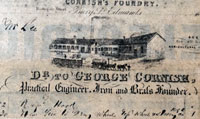
Cornish billhead 1872 |
| 1872 |
This billhead from 1872 shows the Risbygate Foundry as it was at the time.
|
| 1874 |
In 1874 the Bury Free Press moved some of its offices and all of its printing into what was then called Cemetery Road. These offices, now in the re-named Kings Road, continue to be the headquarters of the BFP in 2005. The new printing press was supplied by Mr Boby's St Andrews Works, just across the road, and was powered by a steam boiler. The old presses were also moved into the new Cemetery Road works.
|
| 1879 |
White's issued a new Directory of Suffolk in 1879. By now these Directories were very well developed. The entry describing the history of Bury St Edmunds filled 27 closely printed pages.
The Iron Founders listed were:-
- Robert Boby St Andrew Street South
- George Cornish, 44 Risbygate Street
- Josiah Le Butt St Andrew Street South and Tay-fen Road
- Ransomes, Sims and Head, 5 Meat Market; and Ipswich
- Woods Cocksedge and Co, 22 Meat Market; and Ipswich
|
| 1881 |
In 1881 the census shows George Cornish still living at 44 Risbygate Street, as head of the household. At this address were the following:
- George Cornish, head of household, married, aged 57, born in 1824 at Wilby in Suffolk, "Engineer Iron Foundry employing 19 men and 14 boys,
- Maria Cornish, his wife, aged 50, born in 1831 in Bury St Edmunds,
- Susan Batcock, sister, widowed, aged 67, born in 1814 at Wilby in Suffolk,
- Sarah Butters, sister widowed, aged 65, born in 1816 at Wilby,
- George C Lloyd, nephew, a single man aged 28, born in 1853 at Llanrhidian in Wales, "Clerk to Engineer and Co.",
- William A Lloyd, nephew, single man aged 23, born in 1858 at Llanrhidian, Glamorgan, in Wales, "Assistant to Engineer."
- Mary A Horrer, servant, single woman aged 13, born in 1868 in Suffolk. "Domestic Servant."
Note the two nephews who had joined the firm from Glamorgan. They would become the "Lloyds" of Cornish and Lloyds in the following decade.
|
|
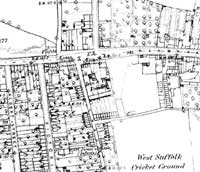
The Cornish Iron and Brass Foundry c.1884 |
| 1884 |
Click on the thumbnail here to see the Risbygate iron and brass foundry in its local context by the time of the OS map scale 1:2500 issued in 1884. The Ordnance Survey has labelled the factory, "Iron and Brass Foundry". It is located just south of Risbygate Street, behind some almshouses, on the east side of Chalk Lane, or Chalk Road as it is known today.
|
| 1885 |
Booksellers, F T Groom were the publishers of the Handbook of Bury St Edmunds, written by Samuel Tymms, Honorary Secretary of the Suffolk Institute of Archaeology and Natural History. Tymms had written many learned papers on the history of Bury, and despite his death, Grooms continued to sell the latest and 5th Edition of his Handbook as Tymms' Handbook of Bury St Edmunds. They had it printed by the London firm of Spottiswoode and Co..
Robert Boby's St Andrews Works was making its famed Self Cleaning Corn Screening and Dressing Machine, having produced over 11,000 units. It had also produced 7,000 Haymakers. Mr G Cornish had "another considerable iron foundry in Risbygate Street." Ransomes of Ipswich and Woods of Stowmarket also had branches in Bury.
|
| 1886 |
On December 2nd 1886, Robert Boby, described as the Proprietor of St. Andrew's Works, died after a protracted illness, aged 72, at his residence in Lower Baxter Street, Bury St. Edmunds. His widow Elizabeth would continue to live at Bloomfield House until her death on January 2nd, 1899, at the age of 72.
George Cornish of the Risbygate Foundry and Engineering Works had a smaller enterprise than Boby’s with their 200 employees, but still employed 50 men and boys making agricultural implements. Harrows and Rollers were a speciality but in 1886 Cornish began making Tayler's new Road Sweeping Machine as well.
|
|
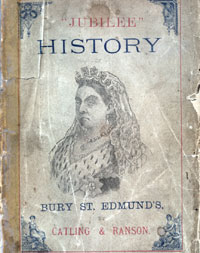
Jubilee History of Bury |
| 1887 |
In June 1887 Messrs Catling and Ranson of 8 Lower Baxter Street, Bury St Edmunds, published this "Jubilee History of Bury St Edmunds" as part of the town's Jubilee celebrations. It contained some 124 pages of Bury's past from 855 up to 1887. It is valuable to us today because of the summary of some major Bury buildings and enterprises as they were in 1887.
|
|
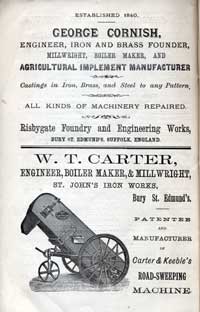
George Cornish advertisement |
|
blank |
The St Andrews Works of Robert Boby received a generous treatment of almost three pages of description. In its first year of production in 1856 the factory produced 200 cornscreens, and by 1887 it had sent over 13,000 such units all over the world. In 1877, following a disastrous fire, nearly all the factory was rebuilt, including a new main office and showroom on the site of Pump Court on St Andrews Street. Boby's employed 200 men in its extensive range of foundries, workshops.
George Cornish of the Risbygate Foundry and Engineering Works had a smaller enterprise, but still employed 50 men making agricultural implements. Harrows and Rollers were a speciality but in 1886 Cornish began making Tayler's new Road Sweeping Machine as well. In this advertisement Cornish claims to have been established in 1840. He also advertised as an Iron and brass founder, millwright and boilermaker, as well as an agricultural implement manufacturer. He would make castings in iron, brass and steel to any pattern.
St Johns Street also held the St John's Iron Works, making various iron machinery and implements. The owner, Mr W T Carter had also designed a Road Sweeping Machine, and had demonstrated it to the Borough Surveyor, Mr J Campbell Smith, in December, 1886.
|
|
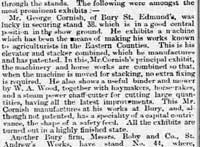
George Cornish at the Suffolk Show in 1888 |
| 1888 |
At the Suffolk Show in 1888, George Cornish concentrated on showing his straw and grain elevators which he had now modified to include stacking facilities and to work by either horse power or steam power.
Josiah Le Butt had set up his own iron works in competition with Robert Boby in 1867. In 1881 he had been recorded
in the census as an Agricultural Engineer, employing 10 men. On 4th April, 1888. Le Butt died at the early age of 57, at number 2, St Georges Terrace. He left a wife Melinda, aged about 49, and a daughter Florence, aged about 23.
Some time after his death it is believed that the Le Butt business was taken over by Robert Boby's.
|
| 1890 |
In June 1890, work was being undertaken to provide a new lock and a new bridge over the River Lark at the Tollgate Inn, just outside Bury. This was part of the work to extend the Lark Navigation from Fornham Wharf to a new wharf at St Saviours. Traffic had to be diverted via the Causeway Bridge, (now called Sheepwash Bridge), over the River Lark at Fornham All Saints. This was a wooden bridge which partly collapsed on 16th June 1890, when a traction engine tried to cross it, coming from Timworth to Bury. Thomas Newell, the driver of the two man crew was killed in the accident. They were employed by George Cornish, one of Bury St Edmunds' engineering firms.
By 1890 William Arthur Lloyd was living at 14 Albert Street and working as a traveller and insurance agent for the Queen Insurance Company.
|
|
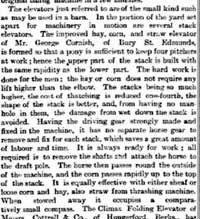
Cornish - Straw Elevators |
| 1891 |
The new Mayor from November 1891 was George Cornish, the Iron Founder. His Risbygate foundry was set up in 1865, and was located in Risbygate Street, and was still trading as Cornish and Lloyds into the 1970's.
This advertisement from the Yorkshire Post of 22nd June 1891, shows that Cornish was diversifying his business offer to include horse driven grain and straw elevators for building stacks.
The 1891 census shows him still residing at 44 Risbygate Street, Bury St Edmunds, as follows:
- George Cornish, head of household, married, aged 67, born in 1824 at Wilby in Suffolk, "Iron and Brass Founder, Engine and Machine Maker, an employer of men,
- Maria J Cornish, his wife, aged 60, born in 1831 at Bury St Edmunds,
- Susan Bantock, his widowed sister,aged 77, born in 1814 at Wilby in Suffolk,
- Sarah Butters, his widowed sister, aged 75, born in 1816 at Wilby,
- James Cornish, a cousin, married aged 54, born in 1837, at Walsingham, in Norfolk, "Ironmonger", an employer of men,
- Laura M Footer, servant aged 20, born 1871 at Thelnetham, Suffolk. "Cook, domestic servant",
- Helen E Kemp, servant aged 17, born in 1874, at Bury St Edmunds, "General Servant"
|
|
1896 |
In the 1896 Directory of Ironfounders, George Cornish is still listed under that name, but by the 1900 directory, the firm was called Cornish and Lloyds.
|
|
1897 |
George Cornish died at age 73 and was buried on 17th April, 1897, in the cemetery at Bury St Edmunds. After this event nephew George Lloyd became more involved with the management of the firm, and began negotiations to acquire the firm from the late George Cornish's executors.
|
|
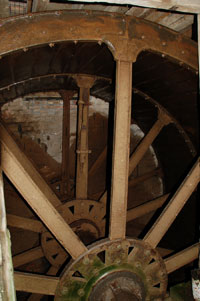
Pakenham mill wheel
|
| 1898 |
Pakenham Mill's Water wheel is 16 feet high, and is the source of the mill's power.
Each spoke bears the impress 'W PECK BURY'. This cast iron wheel was originally designed by Walter Peck, millwright of Sparhawk Street, Bury St Edmunds, and cast at Cornish's foundry in Risbygate Street, Bury, in 1898.
|
| 1899 |
According to records held at the Bury St Edmunds Record Office, reference HB 500/C/8, the company of Cornish and Lloyds was formed in 1899, taking over the late George Cornish's business as an engineer and ironfounder in Bury.
Other business papers cover topics like Risbygate Foundry, Risbygate Street, leased in 1898;
The Spital Almshouses (4 tenements and 16 rods), Risbygate Street, purchased in 1909
Includes:
articles of association, signed 7 April 1899
sale particulars: The Spital Almshouses, Risbygate Street, 1909
|
1900 |
In the 1896 Directory of Ironfounders, George Cornish is still listed under that name, but by the 1900 directory, the firm was called Cornish and Lloyds, as it had been constituted under that name in 1899.
|
|
|
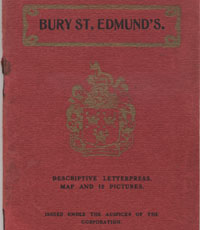
Guide 1906
|
| 1906 |
During 1906 Edward J Burrow of Cheltenham was producing Number 37 of his series of Borough Guides, called "A Guide to Bury St Edmunds". It contained a potted history of the borough, together with a description of its churches, public buildings and local seats of the gentry.
Although Boby's St Andrews Works had taken eight pages of what we would now call "advertorial", the firm of Cornish and Lloyds took no advertising and were not mentioned at all in this "guide".
|
|
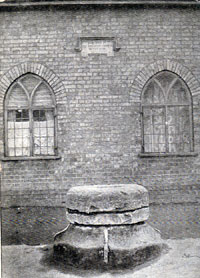
Spittle Houses and plague stone |
| 1909 |
At this time the plague stone was in Risbygate Street, but was in front of a row of 4 almshouses at the foot of Chalk Road, as shown on this postcard.
Cornish’s brass foundry had been set up on land behind these almshouses and in 1909 the company, by now called Cornish and Lloyds, bought the 4 Spital Almshouses in order to demolish them and expand their premises.
The plaque on the wall behind the plague stone reads as follows: "ENDOWED BY / THE REVD JOHN FRENZE/ MCCCCXCIV, (1494). The date 1606 is seen to the left bottom and something over 1672 at the bottom right.
Warren’s map of 1776 Refers to this row as “John Franzes Spittle Houses”, and Chalk Road was not called Chalk Road on the 1776 map, but is “Spittle House Lane”.
The proceeds from the sale of the almshouses went to the Guildhall Feoffment Trust, and the money was used to help build the new almshouses at College Square.
|
|
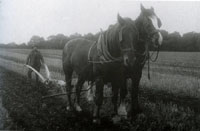
Wooden plough model GCB |
| 1937 |
In 1937 the company’s Risbygate Foundry was advertising their range of ploughs and plough shares. These could be specified in iron or in wood!
Horse drawn ploughs were still in production, as shown by this photograph from Hintlesham, taken from the Suffolk Photographic Survey, published in Robert Malster's "Suffolk at Work" (1995). The caption describes this as a Cornish and Lloyd's GCD plough. However, in the catalogue this is probably model GCB.
|
|
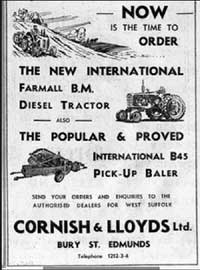
Advertising in 1953 |
| 1953 |
This advertisement by Cornish and Lloyds appeared in the Bury Free Press coronation edition. The firm were turning increasingly to the sales of other companies large agricultural machinery, rather than attempting to produce them in house. The foundry continued to turn out smaller cast iron products for use on the farm.
|
|
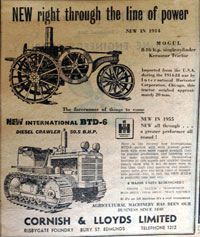
Advertising in 1955 |
| 1955 |
This advertisement by Cornish and Lloyds appeared in the Bury Free Press centenary edition. Once again the emphasis is on the retailing of other manufacturers' products.
|
1963 |
Around 1963 the national company of Dalgety acquired a number of agriculture related businesses in East Anglia. These included not only Cornish and Lloyds of Bury St Edmunds, but Plowrights of Swaffham as well as others.
Later, Dalgety would merge with another business to become Dalgety Franklin Ltd..
|
|
|
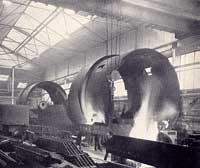 Closure of Boby Engineering
Closure of Boby Engineering
|
| 1971 |
Bury's engineering heritage took a severe blow in 1971 when the Robert Boby works in St Andrews Street was closed down. It had been owned by Vickers since 1927, and was still the biggest factory in Bury. Some 270 men were put out of work, but many Bury people still remember friends or relatives who worked there. Many local men did engineering apprenticeships at Boby's, even if they now live far away.
Some design staff were retained for a further year.
|
|
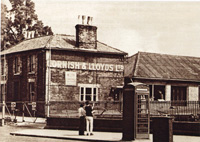
C & L Foundry Risbygate Street |
| 1972 |
In 1972 the old and well established foundry of Cornish and Lloyds closed down their number 44 Risbygate Street site. The site would become the home of DIY specialist retailers, B and Q, with another retail outlet alongside, and a car park for customers.
Although they no longer carried out any foundry work, the firm of Cornish and Lloyds re-opened their agricultural machinery business at Northern Way Industrial Estate. The site was the first unit off the Fornham Road, on the right hand side. It was one of the first units to be let on this new estate.
The remaining design staff at Robert Boby's works finally finished work in the same year of 1972.
|
|
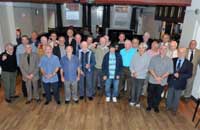
Reunion July 2013 |
| 2013 |
On 6th July 2013, the Bury Free Press published this picture of a reunion of 40 former workers at the firm of Cornish and Lloyds. When it closed "it was owned by Fred Choat and did work for the grain industry and on combine harvesters and council mowers" said the newspaper. The organiser Chris Simpkin (with Adrian Parsland), said it was the 3rd such reunion held since his time between 1956 and 1972, working in the machine and fitting shop.
|
|























